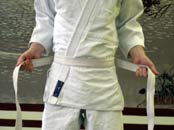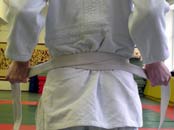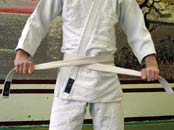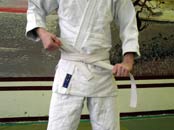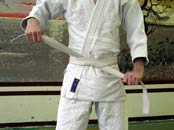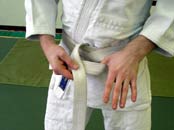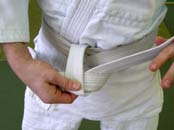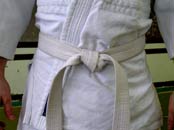Etiquette
The behavior of pupils in Dojo depends on deep respect for a place, for people which are there, and to the purposes for which
dojo exists. In general, it is possible to tell, that their behavior should meet the norms of propriety accepted in a civilized society.
Besides it, the pupil should follow the certain precise rules of behavior as soon as he steps on
tatami, it is the ceremony that came from Japan and accepted in major Japanese martial arts practiced nowadays.
Ritsurei

For example when the pupil steps on
tatami, he should lightly bow aside
kamiza. This bow is carried out according to the rules established for a greeting (
ritsurei).
It is carried out in a normal, natural pose (
shidzen hontai). The trunk is inclined forward approximately on 30 degrees, and tips of fingers touch a forward part of hips above knee. It is usually considered wrong to be declined too low - so that thus the person who is taking place before the pupil, saw his nape.
After the bow the pupil should wait the instructor and spend this time with advantage for itself, carrying out all physical or preparatory exercises if those are not included directly in the training program. The pupil can also sit down, relax and carry out special exercises for development of Internal Forces.
When the training begins, the pupil should take place corresponding to his category among other pupils and sit down in
seiza position.
Seiza

The sitting position calls seiza. To take that position, it is necessary to set aside the left leg on a half-step back and bent it, put a knee to tatami, keeping back and a neck straight. Then the right leg, which puts to left in the same way, so that the big fingers of both legs crisscross or touches each other. The weight of a body should be basically concentrated on heels.
Hands lies upon hips palms downwards - fingers either slightly turned inside, or made in an incomplete fist. The distance between knees should be so that two fists can be put.
Variants of this pose differ from each other only by legs position. It is allowed not crisscross fingers or crisscross legs before itself in a pose of "tailor" (
agura). Thus it is necessary to follow the rule - back should remain straight.
To rise from
seiza - it is necessary to perform all in reverse
The pupil lifts hips from heels, bending fingers of legs and rests their tips against tatami (
sumasaki). The right knee lifts from tatami first, and the right foot puts near the left knee. Then the left knee lifts from tatami, and the left leg puts near right. All movements should be carried out quickly and smoothly.
The instructor usually sits before the group, facing
kamiza, as well as pupils. He gives a signal - usually by a clap. On this signal all group should perform ceremonial bow from sitting position.
Dzarei

Ceremonial bow in dzarei style begins with a starting position -
seiza. Palms are put before the person on tatami on distance approximately 15 sm. from knees, fingers of hands are turned inside. The trunk is bend forward (as in ritsurei) at an angle of approximately 30 degrees, elbows are slightly parted. It is not necessary to bend a head strongly forward - it is important to hold it on one line with trunk. Buttocks should not lift from heel.
After the instructor faces the pupils, he exchanges
dzarei with them. Then the instructor usually stands up and begins warm-up, or if the warm-up was already carried out under the higher category pupils, he tarts the technique demonstration, used in Aikido.
According to etiquette pupils should carry out
ritsurei and
dzarei much lower and straighten up after the bow later than the instructor.
Usually the instructor shows Aikido techniques applied to a certain kind of attack, during it pupils sit in
seiza (in suvatte position). By the instructor signal, pupils bow to him, rise, choose to the partner (thus both carry out
ritsurei) and begin pair learning of the technique. When the instructor claps, pupils sit down again.
At the end of the training/lesson the instructor claps in hands and sits in seiza, facing
kamiza. He and his pupils make dzarei bow, then the instructor bows to pupils and they answer it. Pupils thank the instructor with bow, and on it the training ends.
 For a long time Aikido was covered with the veil of mystery and was known only to the few devoted people. Aikido was born in Japan last century, but the basic of it lies in ancient Japanese martial arts (bujutsu). Aikido was found by Master Ueshiba Morihei, who has combined practical movements of self-defense art of fencing on swords and spears, ju-jutsu, aiki-jutsu and other more ancient martial arts in unique system of physical and spiritual perfection.
From others, born in Japan and become international martial arts, Aikido differs its strongly marked defensive character, deep philosophy, in basis of which lies principle of general harmony though mastering Ki energy, absence of competitions and system of training acceptable to people of any age, sex and physical possibilities.
From the practical point of view, Aikido represents synthesis of many traditional Japanese martial arts and complete effective self-defense system both against armed and unarmed attacking.
In actual fact there is something greater lies in it. Aikido is the Art of Coordination, the way of strengthening body and spirit, concentration of physical energy, a way of finding harmony.
Aikido consists of three hieroglyphs:
(Ai) - means love, harmony;
(Ki) - means internal, spiritual energy;
(Do) - means way.
For a long time Aikido was covered with the veil of mystery and was known only to the few devoted people. Aikido was born in Japan last century, but the basic of it lies in ancient Japanese martial arts (bujutsu). Aikido was found by Master Ueshiba Morihei, who has combined practical movements of self-defense art of fencing on swords and spears, ju-jutsu, aiki-jutsu and other more ancient martial arts in unique system of physical and spiritual perfection.
From others, born in Japan and become international martial arts, Aikido differs its strongly marked defensive character, deep philosophy, in basis of which lies principle of general harmony though mastering Ki energy, absence of competitions and system of training acceptable to people of any age, sex and physical possibilities.
From the practical point of view, Aikido represents synthesis of many traditional Japanese martial arts and complete effective self-defense system both against armed and unarmed attacking.
In actual fact there is something greater lies in it. Aikido is the Art of Coordination, the way of strengthening body and spirit, concentration of physical energy, a way of finding harmony.
Aikido consists of three hieroglyphs:
(Ai) - means love, harmony;
(Ki) - means internal, spiritual energy;
(Do) - means way.
 For example when the pupil steps on tatami, he should lightly bow aside kamiza. This bow is carried out according to the rules established for a greeting (ritsurei).
It is carried out in a normal, natural pose (shidzen hontai). The trunk is inclined forward approximately on 30 degrees, and tips of fingers touch a forward part of hips above knee. It is usually considered wrong to be declined too low - so that thus the person who is taking place before the pupil, saw his nape.
After the bow the pupil should wait the instructor and spend this time with advantage for itself, carrying out all physical or preparatory exercises if those are not included directly in the training program. The pupil can also sit down, relax and carry out special exercises for development of Internal Forces.
When the training begins, the pupil should take place corresponding to his category among other pupils and sit down in seiza position.
For example when the pupil steps on tatami, he should lightly bow aside kamiza. This bow is carried out according to the rules established for a greeting (ritsurei).
It is carried out in a normal, natural pose (shidzen hontai). The trunk is inclined forward approximately on 30 degrees, and tips of fingers touch a forward part of hips above knee. It is usually considered wrong to be declined too low - so that thus the person who is taking place before the pupil, saw his nape.
After the bow the pupil should wait the instructor and spend this time with advantage for itself, carrying out all physical or preparatory exercises if those are not included directly in the training program. The pupil can also sit down, relax and carry out special exercises for development of Internal Forces.
When the training begins, the pupil should take place corresponding to his category among other pupils and sit down in seiza position.

 Ceremonial bow in dzarei style begins with a starting position - seiza. Palms are put before the person on tatami on distance approximately 15 sm. from knees, fingers of hands are turned inside. The trunk is bend forward (as in ritsurei) at an angle of approximately 30 degrees, elbows are slightly parted. It is not necessary to bend a head strongly forward - it is important to hold it on one line with trunk. Buttocks should not lift from heel.
After the instructor faces the pupils, he exchanges dzarei with them. Then the instructor usually stands up and begins warm-up, or if the warm-up was already carried out under the higher category pupils, he tarts the technique demonstration, used in Aikido.
According to etiquette pupils should carry out ritsurei and dzarei much lower and straighten up after the bow later than the instructor.
Usually the instructor shows Aikido techniques applied to a certain kind of attack, during it pupils sit in seiza (in suvatte position). By the instructor signal, pupils bow to him, rise, choose to the partner (thus both carry out ritsurei) and begin pair learning of the technique. When the instructor claps, pupils sit down again.
At the end of the training/lesson the instructor claps in hands and sits in seiza, facing kamiza. He and his pupils make dzarei bow, then the instructor bows to pupils and they answer it. Pupils thank the instructor with bow, and on it the training ends.
Ceremonial bow in dzarei style begins with a starting position - seiza. Palms are put before the person on tatami on distance approximately 15 sm. from knees, fingers of hands are turned inside. The trunk is bend forward (as in ritsurei) at an angle of approximately 30 degrees, elbows are slightly parted. It is not necessary to bend a head strongly forward - it is important to hold it on one line with trunk. Buttocks should not lift from heel.
After the instructor faces the pupils, he exchanges dzarei with them. Then the instructor usually stands up and begins warm-up, or if the warm-up was already carried out under the higher category pupils, he tarts the technique demonstration, used in Aikido.
According to etiquette pupils should carry out ritsurei and dzarei much lower and straighten up after the bow later than the instructor.
Usually the instructor shows Aikido techniques applied to a certain kind of attack, during it pupils sit in seiza (in suvatte position). By the instructor signal, pupils bow to him, rise, choose to the partner (thus both carry out ritsurei) and begin pair learning of the technique. When the instructor claps, pupils sit down again.
At the end of the training/lesson the instructor claps in hands and sits in seiza, facing kamiza. He and his pupils make dzarei bow, then the instructor bows to pupils and they answer it. Pupils thank the instructor with bow, and on it the training ends. 










